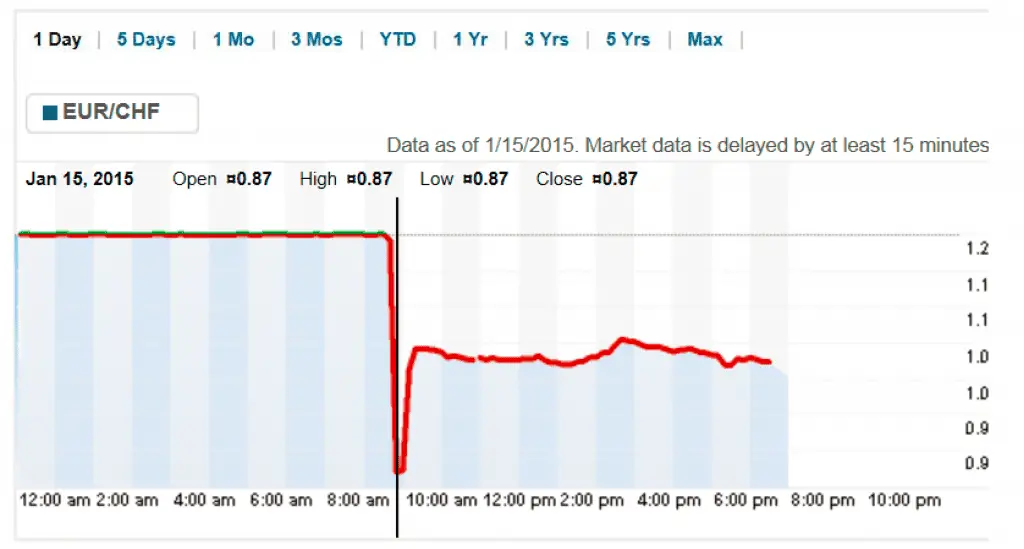What happened on January 15? 2015.?
15. January 2015. was the Swiss franc devaluation in 2015? Or, in simple words, the swiss franc jumped 30 percent after the Swiss National Bank dumped the euro ceiling. A massive disturbance wave hit the Forex exchange market on January 15th, 2015. This was one of the challenging days and will be regarded as a day of infamy. The USD CHF 15th January 2015 incident led to severe economic disturbance because the Swiss National Bank decided to deviate from its promise on September 6th, 2011.
The SNB had promised to defend the strengthening of Switzerland’s currency against the Euro. They did not allow the Swiss Franc (CHF) or CFH to drop below 1.20. While everyone was skeptical, the SNB declared on Jan 12th, 2015, that it would keep its promise. However, they did not respect their word. Three days later, the bank reported that they were dropping the currency at the rate of the 3.25-year peg.

They published a statement on their website to defend their move, leaving everyone gasping.
Reason Behind the Currency Swing
The announcement by the Swiss National Bank generated mass confusion. By removing the peg and cutting the rates; they created economic uncertainties for various traders, investors, and brokers.
Many people were in deep waters when the SNB made the announcement. A part of their official statement detailed that they took stock of the situation in December 2014, a month before the big announcement, and decided to keep the minimum exchange rate as-is. They claim to have looked at all the parameters before making this call. This move was deemed appropriate in conciliation with their monetary policies. After three days, the bank decided to pull the exchange rate, leading to a drop n the EUR/CHF currency pair from 1.20 to approximately an intraday low of 0.85. The change might not seem huge in points, but it roughly translates to a drop of 41 percent.
A famous FX broker, FXCM, uses the Speculative Sentiment Index. They explained how the ratio of sellers of Swiss Franc and buyers of EUR/CHF dropped drastically from 67.3:1 after the announcement by the SNB. Many clients faced significant losses, and they were operating on leverages.
How Did it Begin?
The value of a currency is based on various things, and market forces greatly influence its strength. No central bank alone can deal with these forces. In that decade, there have been multiple failures of central bank programs, the Thai Baht peg to USD being one of them.
Central banks can push the markets in the short run but cannot do the same in the long run. The same thing happened with SNB. They pushed their currency, and the EURCHF 1.20 peg continued for three consecutive years. Ultimately it crashed, and the cost could not be borne as the EUR fell continuously. It led to a potential QE.
The Great EUR/CHF Crash: A Lesson about Currency Market Crashes!
My trades got wiped, and I remembered several minutes of hell during the Swiss franc currency explosion. Traders do not remember an example in the modern history of an advanced currency moving as fast as the Swiss franc did on January 15.
Consequences of the Currency Swing
When something like this happens, the repercussions do not follow immediately. The immediate effects were focused on the small brokers who closed their shops within 24 hours of the announcement. The losses were too significant to be borne by small hedge funds. They also closed their doors.
This happened because many believed that EURCHF would hold the 1.2000 floors. They used leverage while placing the trades. Major brokers and traders did not leave the turf, but the 41 percent drop caused massive losses to many people.
This situation teaches a valuable lesson. The market might seem stable, but there is no guarantee that it will not change its direction. You can have a great strategy, but many forces are beyond your control. Use tools like stop losses to your advantage. Last but not least, trade in small amounts and use leverage wisely.
























